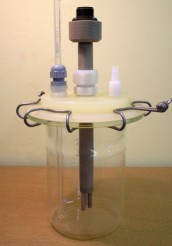Bubble Test is primarily used for testing of oil field inhibitors using the Bubble Test technique. Other names for this test include the Kettle Test and Inhibitor Screening. They are all tests that use the LPR technique with respect to time to calculate the efficiency of oil field inhibitors.
A series of LPR tests are collected over time, giving Corrosion Rate results. Cells (or Channels) are assigned together into Groups, each group has an Add Inhibitor button, once pressed, corrosion rates can be calculated for 3 periods - prior to Add Inhibitor, after 2 hours and after 16 hours (configurable), this enables Percentage Protection to be calculated.
[Bubble Test Manual Version 5]
Bubble Test including Localised Corrosion Monitoring (LCM™)

For use in inhibited solutions.
The standard Bubble Test uses a series of Linear Polarisation Tests over a period of about 24 hours to assess the performance of a corrosion inhibitor. In simple terms it does not give an indication of localised corrosion. However, up to 80% of pipeline failures are ascribed to pitting, but very few monitoring methods are capable to show this outcome. LCM™ attempts to give the user this information as well as the standard Bubble Test information. The test preparation and duration is the same as for a standard three electrode Bubble Test using an Auxiliary, Corrosion Resistant Reference and Test Electrode. The standard Bubble Test data is achieved with or without the addition of LCM™. LCM™ just gives additional information relating to the magnitude and frequency of pitting events.
LCM™ is simple and basically uses Ohms Law and jargon to convert potential transients into charge and metal loss by localised corrosion.
During a localised event electrons are liberated leading to a drop in potential. Once the active localised area is reinhibited, the excess electrons are consumed by the Cathodic reaction and the potential rises again. This can be seen as a potential transient. The trick is to convert this potential transient in to charge using Ohms Law, something we are all generally familiar with.
Ohm's Law R = V / I
I = V / R
V in this case is the potential shift caused by the localised event from the rest potential.
R is the polarisation resistance measured by the LPR technique.
Thus by detecting a potential transient for duration and magnitude, it is possible to calculate the charge associated with the transient and by inference, the amount of metal loss necessary to produce such a transient.
Data is presented in the form of a Histogram showing Number of Localised Events on the y axis and bins representing charge on the x axis. Adjacent bins increase in magnitude by a factor of 10. It’s all to do with relative size and volume, for instance a football that is twice as wide, has a volume that is 8 times as much. A localised event with a measured charge that is ten times greater than a previous event is likely to be produced by a pit that looks approximately twice as big.
Data from these bins is further presented with respect to time. The axis in this case are accumulated charge, or by inference metal loss, v time on the x axis. This enables the operator to add additional inhibitor and see what concentration is necessary to stop large localised events from occurring.
A version of the technique was first used by Prof John Sykes and one of his students on passive metals where a bigger polarisation was used to calibrate transients due to the non linearity of corrosion reactions. However in an inhibited system the overriding parameter that inhibits polarisation is the resistive inhibitor film, thus a doubling of polarisation is likely to simply double the polarisation current, the polarisation resistance remaining very similar. Thus for LCM™ in inhibited systems a simple LPR polarisation is deemed to be good enough for calibration.
A good paper to read relating to LCM™ is “In Situ Assessment of Pitting Corrosion and Its Inhibition Using a Localized Corrosion Monitoring Technique” Corrosion June 2010. The corresponding author was Jeremy Moloney. The paper won awards at a NACE conference.
Jeremy, funded by Baker Petrolite, used an expensive microscope to scan for pit volumes in order to get good correlation with the monitoring technique. Somewhat cheaper methods may involve making moulds of the pitted surface, then cutting off the moulds caused by the pits using a scalpel. Flowable silicon is suggested for this task. These pit models can then be weighed and simple maths used to convert to metal loss.
The LCM™ software uses a series of tools to analyse the data. These tools can be individually manipulated or massed together in a Tool Box. The idea is that corrosion test data can simply be passed through the Tool Box to produce data in a readily understandable format without need for significant analysis.
The LCM™ technique can be fitted as an option to the Gill AC, Field Machine and multiple channel instruments such as the Gill 8 or Gill 12 with simultaneous monitoring on all channels.
- Direct-Assessment-of-Localized-Corrosion-Using-Localized-Corrosion-Monitoring-Technique (PDF)
- Electrochemical-Evaluations-Of-High-Shear-Corrosion-Inhibitors-Using-Jet-Impingement (PDF)
In addition to the papers above, our partners at Baker Hughes, J. Moloney, W. Mok, and C. Menendez, have written a paper on LCM™, titled "In Situ Assessment of Pitting Corrosion and Its Inhibition Using a Localised Corrosion Monitoring Technique". The paper was published in the June 2010 edition of Corrosion and a PDF version can be downloaded here.
The LCM™ Manual in PDF format is also available for download.
Accessories
 |
Bubble Test Cell The Bubble Test Cell has been designed for the every day testing of oilfield inhibitors on steel. It is suitable for standard Bubble test work or for LCM techniques that in addition to the average corrosion rate vs. time gives information pertaining to Localised Corrosion. The Cell is a Quickfit 1 litre reaction vessel with lid and clamp. Several ports are available in the lid for gas injection via a 7mm glass tube, an exhaust, inhibitor injection port with plug and a central chemical resistant three electrode probe. Two versions of probe are available, the ACMP4 probe is supplied with three electrodes, two of which are made from Hastalloy on a 3mm thread, whilst the working electrode, typically made from a mild steel, is on a 10mm 440UNC thread. The intention is to reduce costs in that only the working electrode needs to be replaced between tests, whilst the Hastalloy Auxiliary and Reference Electrodes only need to be cleaned. The ACMP3 probe is supplied with three electrodes, two of which are made from mild steel on a 440UNC thread for the working and reference electrodes, the third is made from Hastalloy on a 3mm thread. For suitable instrumentation see our Gill 8/12 Click here to view more accessories. |
